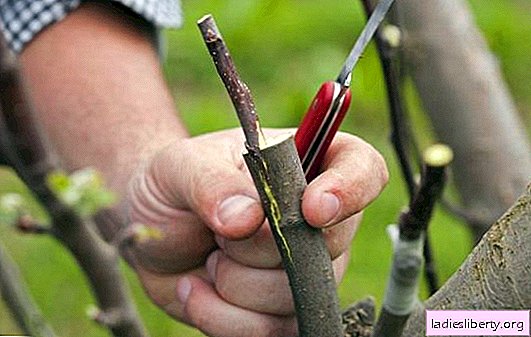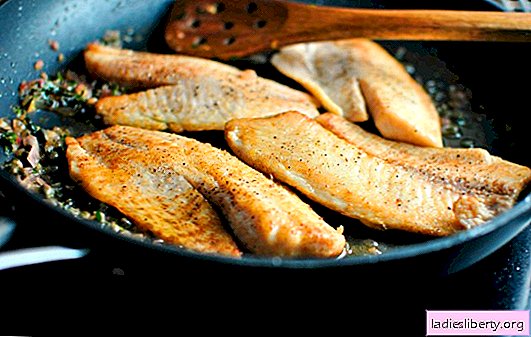
Vaccination of apple trees is an ideal option that allows you to grow the desired variety of apple trees in the garden. Knowing how to perform this operation, you can prepare seedlings from a seed or use a wild tree as a stock.
Vaccination can be compared with surgery. But it allows you to significantly reduce the cost of purchasing seedlings of the variety needed by the gardener, accelerate the fruiting of young trees, grow different varieties on the site and even grow other crops on the apple tree.
Tools and material necessary for grafting an apple tree
Not only different varieties, but also different types of scion (plants that are grafted), for example, an apple tree and a pear can grow immediately on a rootstock (plant to be vaccinated).
Before vaccination begins, need to prepare the following:
• The stock, which is not infected with diseases, can be used for this old tree, and it is cut into a stump;
• Future scion - the stalk of the variety necessary for the gardener;
• Well-ground knife, pruner and pruner;
• Garden var needed to smear wounds (you can use oil paint mixed with varnish with a small amount of copper sulfate instead);
• Tape for garter stock (permissible to replace with strips of plastic film, electrical tape).

Vaccination work needs to be done as quickly as possible, everything needs to be done in 1 minute to protect the cutting sites from drying out, so it is advisable to practice well in advance. Often, to preserve the moisture of the scion, it is moistened with saliva during operation, during the preparation of the stock.
When is it best to plant apple trees
It is best to plant apples in the spring, during this period the tree heals the wounds better. It is only necessary to be in time before the spring current of juice begins. During the summer period, it will be possible to find out whether a young branch has taken root. Autumn vaccination may not work, as there is a risk that the scion will simply freeze.
Optimum cutting time for cuttings
It is best to plant an apple tree in spring, the optimal time for this work in most regions begins from April 10-15 and lasts until the last decade of May. It is best to get vaccinated on a cloudy and dry day. No need to start this work in the rain or in hot weather.
Cuttings for vaccination are best cut in late autumn, after the onset of frost, you need to harvest annual shoots, and wrapping them in a damp cloth, put them in the refrigerator or cellar for the winter. If it was not possible to do this in the fall, you need to prepare the cuttings in the early spring before the buds begin to swell. Before work, you need to disinfect the tool and wash your hands well to reduce the risk of infection in a fresh wound.
Ways to vaccinate apple trees in spring
An apple tree can be planted in several ways:
1. Vaccination with a bridge;
2. Vaccination for bark;
3. Vaccination in the split;
4. Copying (with tongue, normal, improved);
5. Cowing.
Less often, in some cases, instead of the handle, the rootstock is budded.
Copy Method
This technology is used only if grafts and stocks of the same diameter are used. It is necessary to make absolutely identical slices on them (so that the bark on the shoots coincides as much as possible across the entire diameter). The grafting secateurs perform the same sections, and the shoots take root well. The work needs to be done very quickly, you need to spend no more than one minute. The dried section greatly complicates the splicing of shoots.

Copying with the tongue is more difficult to make, it is necessary to make another cut, both on the scion and on the stock, on top of the transverse sections.
Spreading the prepared incisions, you need to carefully insert the shoots into each other so that the branches do not crack further. In this case, cambium (the tissue located between the wood of the stem and the bark) grows much faster, and the risk of sprouting is reduced. The site where the vaccination is made must be smeared with garden var and tightly wrap with plastic wrap or special tape.
Split vaccine
This is a popular method of vaccination; it is often used due to its simplicity and good survival rate. The rootstock and scion of the same thickness are selected, if necessary, using this technology, thin cuttings can be grafted onto a thick branch, it is evenly cut across and made in the middle with a sharp knife. Into the resulting slit, insert the cuttings pre-cut obliquely in such a way that the cambium of the branch and the cuttings exactly match.
Vaccinations for bark
A simple way in which the stalk quickly grows to a stock.
The priva needs to be prepared in this way:
• Cut the cuttings together with a small amount of wood, this part is attached to the nearest branch (it is necessary to make a perfectly even cut);
• A vertical cut is made on the rootstock, after which the bark is carefully peeled off with a knife;
• A graft is introduced beneath it, and the area where the shoots are docked is greased with garden var, after which they wrap this place with plastic wrap from below and above.

Vaccination in the lateral incision
This technology resembles grafting into a split, the difference between them is that the split is performed on an evenly trimmed branch into which the stem is inserted, grafting into the lateral notch, it is not necessary to trim the branch on the tree (graft and rootstock are joined together to create a structure similar to cattle).
First of all, 2 oblique slices are made on the handle, which should be connected in the lower part. An incision is made on the rootstock and the bark is carefully bent, a graft is introduced under it so that the bark and cambium of both shoots are joined as evenly as possible. The site where the vaccination was performed should be smeared with var and tightly wrap with a film.

How to plant different types of trees on each other
You can create a real garden on one tree, where not only different varieties will be developed, but also several types of fruit plants.
There are such varieties:
1. Intraspecific vaccinations (a combination of different varieties of the same species);
2. Interspecific vaccinations (for example, cherry vaccination on cherries);
3. Vaccinations intergeneric (for example, chokeberry on an apple tree).
Compatibility of stocks and scions

You can not combine any trees, for this reason you need to understand which of the scions can take root on a certain stock, and which even makes no sense to experiment. For example, you can plant a pear on an apple tree, with the right choice of the method of vaccination and the exact execution of the work.
Knowing the different types of vaccinations for apple trees, it’s easy to find a suitable and easy way. It is better for an inexperienced gardener to plant trees in a split, this is an effective and simple technology, although it will require certain labor costs.











